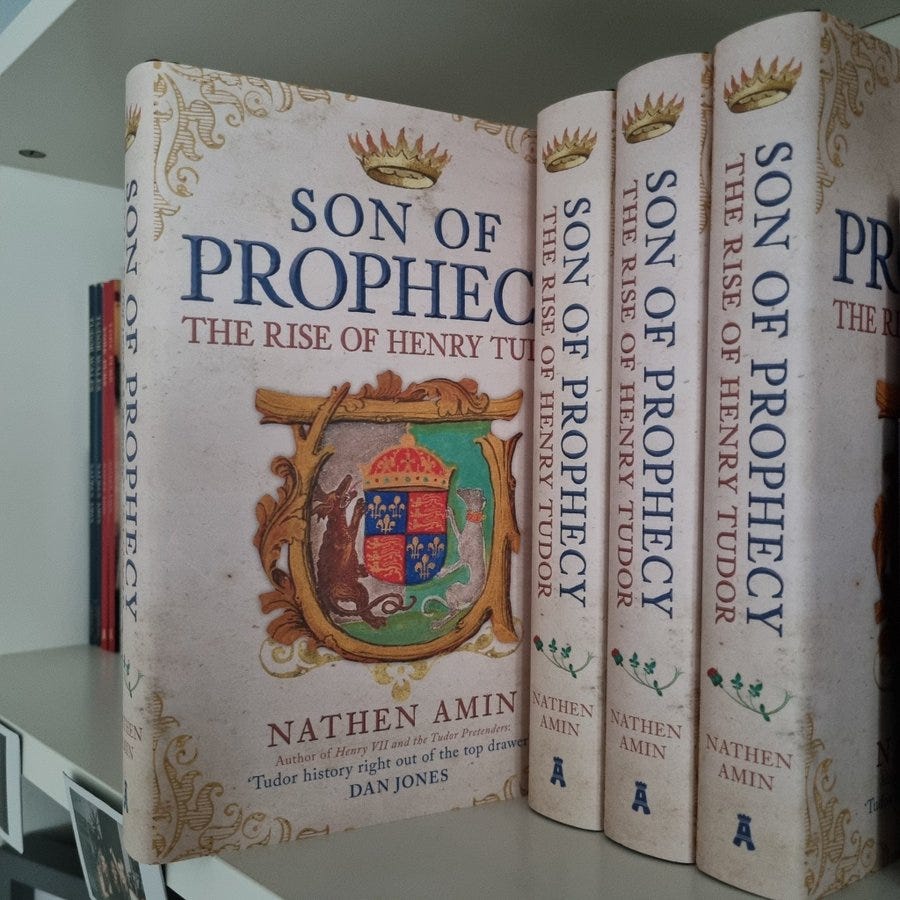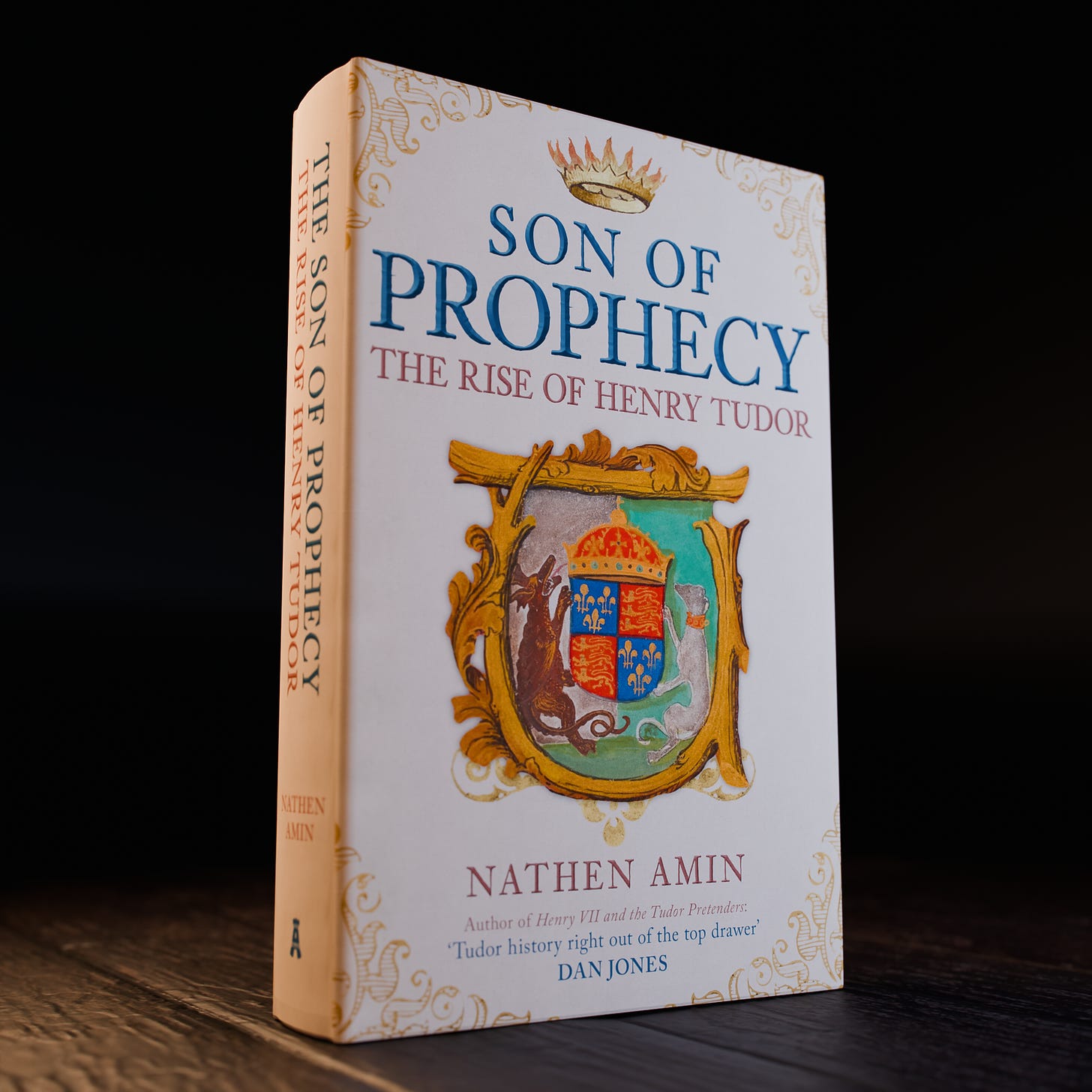How did Owen Tudor and Katherine of Valois meet?
An exclusive extract from Son of Prophecy: The Rise of Henry Tudor
So, ten years in the planning and research and four years in the actual writing and editing, the book I always dreamed of writing, ‘Son of Prophecy: The Rise of Henry Tudor’ is HERE. I have held it, it exists, it’s beautiful.
So to celebrate, and hopefully hook some of you into buying a copy (details of which below), here’s an adapted extract from the book, just for you.
Historians, poets, and novelists throughout the centuries have long speculated over how a modest Welsh squire like Owen Tudor and a French-born queen dowager of England met, though contemporary accounts reveal frustratingly little. The two most well-known accounts originate from the work of a pair of Welshmen, Elis Gruffydd and Robin Ddu.
According to Gruffydd, a soldier and chronicler who completed his work in 1552, one summer Owen was swimming in a river near Katherine’s court when he was pointed out to the queen dowager by one of her handmaidens. This maid disclosed to the queen that Owen claimed to be in love with her, and every time she left Katherine’s side, he would lie in wait for her. The queen noted the fairness of Owen’s body, her eyes following him as he frolicked in the water with his colleagues. Turning to her maid, Katherine ordered her to schedule another tryst with Owen, though this time she would attend in disguise.
Dressed as the maid, Katherine met an unwitting Owen in a darkened gallery as had been arranged, her face obscured. The couple gently conversed before Owen took the disguised queen by the neck and tried to kiss her on the mouth, though she calmly turned her face to present her cheek. A flickering shadow in the light under the door unsettled Owen, worried the queen might interrupt completely oblivious she was already in the room.
As he rose to leave, Owen attempted another kiss on the mouth, but rejected for a second time started to suspect the lady before him was not the handmaiden of previous meetings and that he was the subject of a prank. Determined to uncover the mysterious maid’s identity, Owen nibbled her on the cheek, causing a small mark that would reveal her to him the following day, before fleeing the gallery.
The following morning, Katherine instructed her chamberlain to order Owen to attend to her table during dinner. As he placed the food before the queen dowager, Katherine crossly pointed at her bandaged cheek, shaming Owen for his conduct the previous evening. Terrified he was in grave danger for assaulting the king’s mother, Owen hurried to the stables intending to flee to Wales. Katherine, however, hampered his escape by commanding the gates closed and sending a messenger to bring Owen into her presence. It was from this second meeting an unlikely romantic relationship between the pair developed, though Gruffydd is vague on the details
The story of Owen sexually assaulting and then injuring a disguised Katherine before she fell in love with him seems far-fetched, and surely less likely than the account of Robin Ddu. Also hailing from Anglesey, Robin Ddu knew Owen personally and if his information did not originate with Owen himself, then it is likely to have been obtained from someone within his inner circle.
In an elegy composed shortly after Owen’s death, Robin claimed that he had ‘clapped his ardent humble affection on the daughter of the King of the land of wine’ during a feast celebrating a holy day. This is the earliest known account of how Owen and Katherine met and was a version favoured by later Tudor writers and poets like John Stow, Michael Drayton, and Hugh Holland, who added that he even fell into the queen dowager’s lap.
There may have been another scenario through which Katherine and Owen became acquainted. After Henry V’s death, Katherine was granted several lands in Wales, including Hawarden, Montgomery, Builth, Menai, Flint, Mostyn, and Caldicot, the revenues from which she used to contribute to her place in the king’s household. She was also granted property at Beaumaris, Newburgh, Cemaes, and Aberffraw on Anglesey, an island Owen was intimately connected with.
If indeed he was around the royal household at this time, it raises the possibility his local knowledge was exploited by the queen’s officials, perhaps even personally assisting in the collection of her revenues. As two young adults living in a country in which they were strangers, a strictly formal interaction could soon have developed into a close bond as they explored shared experiences, a connection that over time evolved into a romance. Owing to their difference in their station, however, the impetus surely came from the queen.
The relationship between Katherine and Owen progressed quickly once they became involved, and soon the pair were married. As to be expected from a clandestine union that defied the council’s wishes, however, there is no extant record of how, where, or indeed when, the marriage took place. A reasonable assumption that the nuptials occurred between November 1427 and November 1429 can be made from the testimony of Sir John Steward, a Scottish knight who was keeper of Katherine’s horses and responsible for her travel arrangements. According to a manuscript compiled by his descendants he was questioned by the council shortly thereafter about his knowledge of Katherine and Owen’s affair.
During Steward's interrogation, which took place during Katherine's lifetime and confirms the council were aware of the queen’s remarriage before her death, the Scotsman proved discreet, declaring he could in no good conscience reveal his lady's secrets. To do so, he affirmed, would be ‘to the perpetual shame of his name and estate’. Steward did however deny any involvement in Katherine and Owen’s plans to marry, noting he was serving in France at the time, the dates of his service falling between November 1427 and November 1429.
That no contemporary ever cast doubt on the wedding in subsequent years, nor the legitimacy of their offspring, strongly indicates a ceremony took place, and if Steward’s testimony is truthful, before the end of 1429. Even Richard III, when later attempting to denigrate Henry Tudor’s background in the months before their confrontation at Bosworth, never remarked upon the status of Katherine’s Welsh marriage.
All that can be surmised from the crumbs of material available is that once Katherine had extricated herself from prying eyes and inquisitive minds around the king’s household, she was almost certainly joined in holy matrimony with Owen, requiring just a single priest to conduct the rituals and their own consent. Considering their background, the vows were likely expressed in the one language they had in common, English. The union was unquestionably consummated as proven by their later children.
History has not judged Katherine, a French princess by birth and an English queen by marriage, kindly for entering a union with a man who, though of gentle birth and descended from Welsh royalty, was patently below her social status. One of the earliest contemporary accounts which covered Katherine’s second marriage was the Incerti Scriptoris Chronicon Angliae, compiled around 1460 and which chastised the queen for her apparent inability ‘to control her fleshly passions’, a condemnation rooted in misogynistic attitudes towards female behaviour prevalent throughout written history.
This approach proved influential, and similar judgements were repeated throughout the sixteenth century and beyond. In 1534, Polydore Vergil contended that ‘being but young in years’ Katherine was ‘of less discretion to judge what was decent for her estate’, whilst in 1548 Edward Hall condemned her behaviour as that of a woman who was ‘young and lusty’ and regarded ‘more her private affection than her open honour’.
These accounts were repeated by Raphael Holinshed in 1577 who in turn inspired playwrights like Marlowe and Shakespeare and later generations of historians. Owen, meanwhile, was predictably excused from responsibility and rather praised on account of his appearance and character – to Vergil, he was a ‘gentleman of Wales, adorned with wonderful gifts of body and mind’, confirmed by Hall who added he was ‘a beautiful person’, both of ‘nature and grace’.
History may have been written by the victors, but it was also written by men.
Son of Prophecy
'Son of Prophecy: The Rise of Henry Tudor' is a 300-year history of one Welsh family, and how they emerged from the wilds of Gwynedd, navigated the murky and violent waters of Welsh-Anglo politics, and eventually found their way, almost improbably, onto the English throne. This story involves war, treason, escapes and love.
Fourteen years in the making, from defiant Welsh rebels to unlikely English kings, this is the story of the Tudors, but not how you know it.
Signed Copies
To order signed copies, please head to Fox Lane Books by clicking HERE
US and Rest of the World
Son of Prophecy is released around the world on 14 November, BUT a UK bookseller called Blackwell Books ships WORLDWIDE for free of charge. So to get your copy early, head HERE






This looks brilliant Nathen - I will definitely be ordering a copy of the book! Thanks for sharing this preview. I love a story of medieval romance 🥰